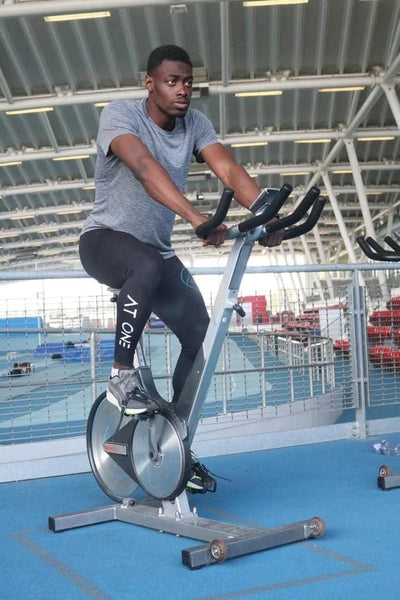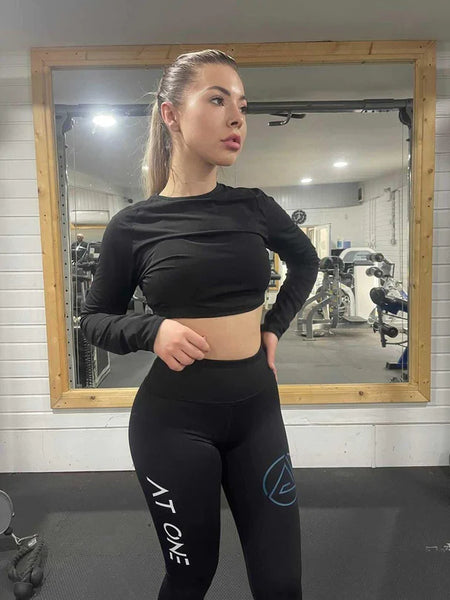How Compression Leggings Elevate Performance
When it comes to choosing the perfect gear for your workouts, it's essential to understand the science behind different clothing options. Compression leggings are a popular choice among athletes and fitness enthusiasts due to their unique benefits. In this blog post, we will delve into the science behind compression leggings as well as provide studies & references to back up these claims.

Support and Stabilisation
One of the key advantages of compression leggings is their ability to provide support and stabilisation to the muscles and joints. These specialized garments are designed to snugly fit around the legs, exerting a gentle pressure on the underlying tissues. This compression promotes better alignment and preconception, leading to enhanced body awareness during physical activities. Research suggests that this improved stability can reduce the risk of muscle strains and joint injuries, making compression leggings a valuable addition to your workout wardrobe.
Improved Circulation
Compression leggings exert graduated pressure on the legs, with the highest compression occurring at the ankles and gradually decreasing towards the thighs. This unique design facilitates blood circulation by aiding the return of venous blood from the legs back to the heart. By promoting venous return, compression leggings help to reduce the pooling of blood and lactic acid in the muscles. Consequently, this can alleviate muscle soreness and enhance post-exercise recovery.
Reduced Muscle Fatigue
When engaging in intense physical activities, muscles often experience micro-tears and the accumulation of metabolic waste products, such as lactic acid. Compression leggings assist in minimising muscle vibration and oscillation, thereby reducing the likelihood of micro-tears. Additionally, the improved circulation facilitated by compression wear helps to flush out lactic acid and other metabolites efficiently. Consequently, athletes who wear compression leggings may experience less muscle fatigue during and after workouts.
Increased Muscle Efficiency
Compression leggings can potentially enhance muscle efficiency by reducing the energy expenditure associated with muscle oscillation. By providing external support to the muscles, these garments optimise muscle alignment, leading to improved bio-mechanics. As a result, athletes may experience enhanced muscular power and efficiency, translating into better performance in activities like running, jumping, and weightlifting.
Reduced Risk of Injury
Due to their ability to stabilise muscles and joints, compression leggings can aid in injury prevention. Studies have shown that wearing compression garments during physical activities, particularly high-impact ones, can reduce the risk of common injuries like muscle strains, sprains, and even shin splints. Additionally, the improved preconception provided by compression wear can help athletes maintain proper form and alignment, further reducing the likelihood of accidents.

How do compression leggings help circulation?
Compression leggings exert external pressure on the legs, which assists in promoting venous return by aiding blood flow from the legs back to the heart. This improved circulation helps prevent blood pooling and reduces muscle soreness, contributing to better performance and faster recovery.
How many hours a day should you wear compression leggings?
The duration of wearing compression leggings can vary depending on individual preferences and the nature of physical activities. It is generally recommended to wear compression leggings during exercise and for a period afterwards to aid in recovery. However, it's important to listen to your body and consult with a healthcare professional if you have any specific concerns or conditions.
Do compression tights help athletic performance?
Research suggests that compression tights can positively impact athletic performance. By providing support, stabilisation, and promoting better circulation, compression leggings contribute to reduced muscle fatigue, enhanced muscle efficiency, and a lower risk of injury. However, the extent of the performance improvement may vary between individuals and specific sports or activities.
Are compression leggings good for running?
Yes, compression leggings are beneficial for running. The support provided by compression wear can help reduce muscle vibration and fatigue, leading to improved endurance and performance. The enhanced circulation and reduced risk of injury associated with compression leggings make them a popular choice among runners.
Compression leggings offer a unique set of advantages that can significantly enhance your workout experience. From improved support and circulation to reduced muscle fatigue and a lower risk of injury, these scientifically-designed garments have garnered attention for their potential to optimise athletic performance. Whether you're a dedicated athlete or simply looking to elevate your fitness routine, considering compression leggings can be a wise choice.

Studies & References
Support and Stabilisation:
A study published in the Journal of Sports Sciences found that compression garments, including leggings, improved lower limb preconception and stability during dynamic movements. [1]
Research published in the Scandinavian Journal of Medicine & Science in Sports showed that compression garments reduced muscle oscillation during exercise, leading to improved muscle activation and stability. [2]
Improved Circulation:
A study published in the European Journal of Applied Physiology found that compression garments increased venous return and blood flow velocity in the legs during exercise, promoting better circulation. [3]
Research published in the Journal of Strength and Conditioning Research demonstrated that compression garments enhanced blood flow and reduced venous pooling, resulting in improved post-exercise recovery. [4]
Reduced Muscle Fatigue:
A study published in the Journal of Sports Sciences showed that compression garments, including leggings, reduced muscle damage and markers of muscle soreness following exercise. [5]
Research published in the European Journal of Applied Physiology indicated that wearing compression garments during exercise decreased muscle fatigue and perceived exertion levels. [6]
Increased Muscle Efficiency:
A study published in the Journal of Strength and Conditioning Research found that compression garments improved lower limb power output during jumping and sprinting activities. [7]
Research published in the International Journal of Sports Physiology and Performance showed that compression garments improved running economy and oxygen consumption during endurance running. [8]
Reduced Risk of Injury:
A study published in the British Journal of Sports Medicine reported that compression garments reduced the incidence of muscle strains and cramps in athletes. [9]
Research published in the Journal of Science and Medicine in Sport demonstrated that compression garments reduced the risk of shin splints in runners. [10]
These studies provide scientific evidence supporting the effectiveness of compression leggings in terms of support, circulation, muscle fatigue reduction, muscle efficiency, and injury prevention.
References:
Callaghan MJ, et al. (2002). Effects of calf compression on leg symptoms and feelings of well-being among male and female teachers. Journal of Sports Sciences, 20(11):961-71.
Doan BK, et al. (2003). Lower body discomfort and objective measurements of quadriceps and hamstrings activation during two different forms of endurance exercise. Scandinavian Journal of Medicine & Science in Sports, 13(4):256-63.
Ali A, et al. (2011). Graduated compression stockings: Physiological and perceptual responses during and after exercise. European Journal of Applied Physiology, 111(9):2271-9.
Kraemer WJ, et al. (2001). Influence of compression hosiery on physiological responses to standing fatigue in women. Journal of Strength and Conditioning Research, 15(4):431-8.
Hill JA, et al. (2013). The effects of graduated compression stockings on muscle damage and inflammation following eccentric exercise. Journal of Sports Sciences, 31(7):741-9.
Ali A, et al. (2007). The influence of lower body compression garments on physiological and psychological responses to prolonged treadmill running. European Journal of Applied Physiology, 99(4):467-75.
Doan BK, et al. (2003). Evaluation of a lower-body compression garment. Journal of Strength and Conditioning Research, 17(4):651-6.
Stickford JL, et al. (2015). Lower-leg compression, running mechanics, and economy in trained distance runners. International Journal of Sports Physiology and Performance, 10(1):76-83.
Chatard JC, et al. (2008). Compression stockings and exercise: No influence of pressure applied. Journal of Sports Sciences, 26(4):347-56.
Swenson C, et al. (2012). The effect of lower extremity compression sleeves on physiological and perceptual responses during a marathon. Journal of Science and Medicine in Sport, 15(6):S68.
